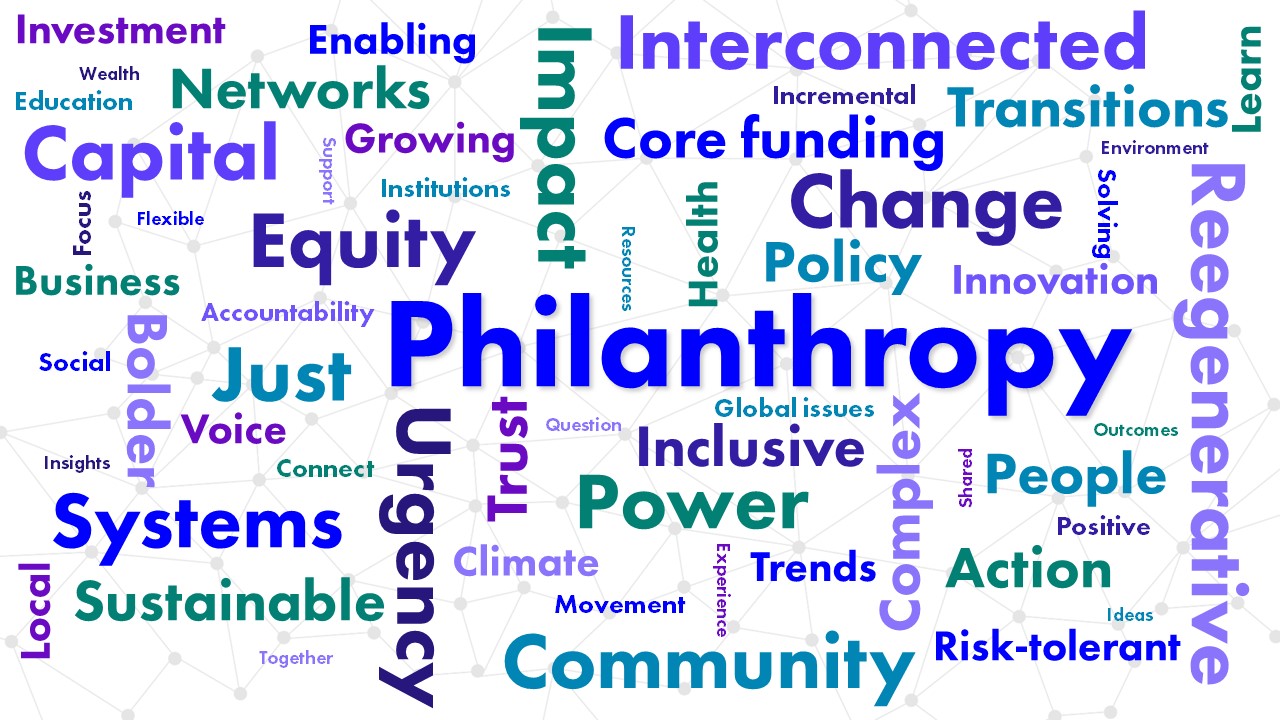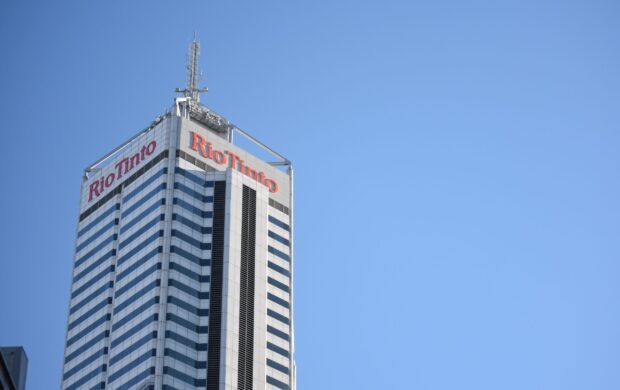For the latest in Forum’s Future of Sustainability series, Jane Lawton, Forum for the Future’s Chief Development and Communications Officer and Clare Baker, Forum’s Senior Global Development Manager, share insights from grantmakers, grantees and philanthropic networks which explore how philanthropy might become a greater catalyst for change – fully leveraging its power to test new approaches and shift systems.
Although the capital deployed through philanthropy is tiny compared to the finance flowing through capital markets, the sector’s ability to provide flexible, risk tolerant capital can be a powerful and much-needed ingredient in creating change. The sector is rapidly evolving, with new forms of philanthropy emerging around the world, next generation philanthropy and the paradigm-shifting power of huge funders being brought to bear on global issues.
Yet philanthropy risks missing the boat in realising its potential to create truly transformational change – held back by risk-averse approaches and an inability to connect the dots across the issues it is working to solve. More fundamentally, there are many ways in which philanthropy may actually be holding in place the structural inequalities and global challenges it seeks to overcome.
At this critical inflection point in time, we share insights from grantmakers, grantees and philanthropic networks which explore how philanthropy might become a greater catalyst for change – fully leveraging its power to test new approaches and shift systems.

While each participant brought a different perspective from where they sit in the system, our interviews with them surfaced a number of common insights including:
- A positive trend towards more systemic approaches to change, moving beyond rigid approaches to impact measurement;
- Ongoing gaps in connecting environmental and social issues, and collaborating effectively across sectors – most notably a real lack of engagement with the private sector, and support of a strong public sector;
- The critical need for philanthropy to examine its own approaches to ensure it is not contributing to structural inequality, and to find ways to shift the balance of power and build relationships of deeper trust with their grantees, partners, and across sectors;
- A call to action for philanthropy to do more to leverage its unique position as a change agent with the capital, influence and risk tolerance to enable bold, innovative and long-term change even in the most challenging of contexts.
We would like to thank Dr Miatta Fahnbulleh, CEO, New Economics Foundation (NEF); Heather Grady, Vice President, Rockefeller Philanthropy Advisors (RPA); Sara Hossain, Executive Director, Bangladesh Legal and Aid Services Trust (BLAST); Leslie Johnston, CEO, Laudes Foundation; and Kevin Teo, COO, Asian Venture Philanthropy Network (AVPN); for sharing their experience and insights with us.
Three positive trends in philanthropy that are enabling greater impact
Over the past 25 years there have been a number of positive shifts in philanthropic giving as the sector has developed and responded to the growing complexity of global challenges.
- Some philanthropies are moving beyond a rigid approach to impact measurement to looking at change more systemically, and investing in building an ecosystem that will provide the enabling conditions for change.
“What I’ve seen in the last five years is the pendulum swinging away from an obsession with measurement to systems approaches which look at changing the underlying conditions holding the problem in place. Now we’re moving faster toward funders collaborating, working with a network of connected organisations aimed toward a shared goal and vision.”
Heather Grady RPA
“Any foundation working on system change has to be doing core funding. COVID-19 was really a wake-up call in this regard – philanthropy realized it needed to be more flexible and to give more core support in order to keep the field alive. A lot of the areas we are working in are embryonic, which means we need to strengthen the institutions first, and core funding is critical for that.”
Leslie Johnston, Laudes Foundation
- The sector is also responding to new areas of need, often before other sectors have fully embraced them.
“I don’t think we can underestimate the importance of philanthropy for the climate movement and for the new economy movement which would not have burgeoned and grown in the way they had without philanthropic funding.”
Miatta Fahnbulleh, NEF
“Philanthropy is increasingly active in justice and access to justice such as gender based violence in Bangladesh. It is filling a gap as bilateral donors are withdrawing due to economic and geopolitical changes rejigging priorities; extreme poverty, COVID-19, and Afghanistan are diverting funding from other development concerns.”
Sara Hossain, BLAST
- Although the north-south divide is still very much in play – with a high percentage of philanthropic funding to poorer countries flowing from the global north – the increase in wealth and philanthropy in other regions is shifting this balance fast, and driving some new approaches that could influence the entire sector.
“The fastest growth in philanthropy anywhere in the world is in China, with other hotspots in Brazil, Colombia, and India. Philanthropists I have worked with in Colombia are bemused at the idea that funders would be engaged in philanthropy that doesn’t involve working directly with communities or beneficiaries of their funding. But there are many US philanthropists who barely interact with the local community, yet feel that is appropriate. So there is a strength in domestic philanthropy [outside the US] that is undervalued and underreported.”
Heather Grady, RPA
“The rest of the world could learn from Asia how to take a more equitable approach. The ‘E’ of ESG is more advanced, especially in Europe, but the ‘S’ is still developing. But the ‘S’ dimension is a key aspect of philanthropy in Asia and could be one of the ways a mutual exchange of learnings on both sides [geographically] on what impact is about.”
Kevin Teo, AVPN
Do more to connect environmental and social outcomes
While the Sustainable Development Goals (SDGs) have helped enshrine the idea that social, economic and environmental problems and their solutions must be interconnected, there is no question that efforts by philanthropy to connect across issues and sectors need to go further if they are to be long-lasting and avoid unintended consequences.
“There’s a world in which we achieve the green transition but we’ve hammered everyone in that process and we have lost all public consent for doing it. On the other side we’ve got a load of philanthropies interested in mitigating the social consequences of our system, and they see climate as a headache they can’t deal with. There is only a tiny subset thinking about how you bring the two together.”
Miatta Fahnbulleh, NEF
Partner more effectively with the public sector
There is also a critical need for many philanthropies to be truly collaborative – ensuring their efforts are complementary to those of the public sector, while also enabling learning, innovation and bringing in different knowledge and perspectives.
“I have seen no real progress, possibly even a regression, in philanthropy understanding the importance of the public sector. For example, it’s a shame that funders are giving to health work in Africa but not paying any attention to the plans or role of the ministries of health. Or education funders in the US who pay no attention to changing education outcomes by influencing fiscal policy for greater redistribution of resources between rich and poor neighbourhoods.”
Heather Grady, RPA
“Bangladesh is a victim of climate change, an important voice in calling for global activity and accountability. But the rhetoric that the state is engaged in internationally is different to the local view. If governments bulldoze climate refugees locally this does not match their international-level conversation. How can philanthropy operate both at the high table and locally?”
Sara Hossain, BLAST
More positively, some philanthropies in Asia are experimenting with new ways to enable policy innovation:
“Venture Philanthropy – catalytic entrepreneurial capital – is best placed to challenge the status quo and fund new models for interventions. This [funding] was previously directed at social entrepreneurs and enterprise. There is a move towards innovative ideas from public servants too. AVPN’s Asia Policy Forum engages with policy makers to get private funders to support some of their ideas to make change as it is not in standard government budgets to do so.”
Kevin Teo, AVPN
Provide the patient, flexible capital needed to deliver system change
As the world goes through a number of key transitions toward the new energy, food and economic systems that will be needed to create transformational change, there is a recognition that short-term investments will no longer deliver. This has been a criticism for investors and the business community for some time.
While philanthropy – unburdened by the need to deliver shareholder return – has the potential to drive longer-term approaches, there are still very few funders investing at the time scales required for systemic change, and not enough are providing flexible capital that demonstrates trust in the ability of their partners to create change.
“Lots of funders are funding in a short-term, project-based way that actually detracts from the very collaboration you need from your actors to drive the change they want. When you are trying to drive big structural changes it just doesn’t play out in that way, and I think the ability to recognize that and adapt is far too slow for the urgency of the challenge and the pace of change that we want.”
Miatta Fahnbulleh, NEF
“[Funders should] not focus tightly on project deliverables but more on core funding, allowing an organisation to be flexible and focus on its USP and use it [funding] the way it thinks, and knows from hard won experience, is best.”
Sara Hossain, BLAST
“We know the global economic system needs significant change. That is going to require very patient capital. We need at least a 10-year runway if not more and to be putting significant resource behind that.”
Leslie Johnston, Laudes Foundation
Address issues of power and equity to create a more just and regenerative sector
Central to the historic notion of philanthropy is that there is a giver and a receiver. The power imbalance inherent in this concept makes questions of power and inequality very challenging for a sector that is trying to solve the same issues. We are seeing a growing recognition among many big philanthropies of the need to address inequality, lack of inclusion and harmful power dynamics in their current structures and practices.
“In the last few years George Floyd’s murder and the Black Lives Matter movement shook US society. Commentators on philanthropy, whether inside or outside the sector, are now being much more provocative about how philanthropy is working vis-à-vis power issues, and really questioning the status quo of power dynamics.”
Heather Grady, RPA
Transforming the power dynamic is a complex undertaking, and an ongoing journey for most philanthropies. As in other sectors, this often starts with acknowledging the underlying tension between the source of the wealth and the change the institution is trying to create in the world.
“The question of philanthropy and its own contribution to structural inequalities is part of the conversation. More organisations are looking at this dynamic, including in Asia, where family business is the main backdrop. Donations come from businesses where there is a conflict between how profits are being generated and philanthropic aims. How could the same decision-maker think about how the business is run and philanthropic efforts – so that together they make sense?”
Kevin Teo, AVPN
“Where family foundations are transitioning to being run by a Chief Executive and Board of Trustees there’s far more openness to have a conversation about where the money’s coming from, how we make sure we’re making the right investments in order to keep growing the pie. It is much harder to have these conversations the closer you are to the source [of wealth], but even with the foundations that are at the vanguard of doing this it’s still quite incremental.”
Miatta Fahnbulleh, NEF
Transforming power dynamics will likely also require new approaches to governance, both within institutions as they examine the makeup of their staff and their boards of trustees, and overhaul their granting mechanisms and practices to ensure they are more inclusive.
“If philanthropies aren’t willing to invest in local engagement it can be a barrier. It is easier to hang out with a few inspiring people and live in that stratosphere instead of dealing with what happens down below. [Philanthropies] need to learn more, and have a better understanding of what interventions have impact. Not just from people whom they meet at Davos.”
Sara Hossain, BLAST
“As long as you’re giving people money there is a dynamic there. And the way you break that is to create flexibility, so you move to things like core funding, basically saying we trust you to deliver these outcomes. I think that shifting the terms of the funder relationship is the thing that negates the power.”
Miatta Fahnbulleh, NEF
“The risk is that foundations like to do their own thing – even though there are more coalitions and they are collaborating more, the sector is still a bit of a black box. If we are stepping up to hold business accountable – who is holding us accountable as a sector?”
Leslie Johnston, Laudes Foundation
Some pilots and new ways of working show how philanthropy can respond to these challenges:
“In the Philippines and Australia, Fund for Shared Insight is looking to emphasise listening tools and funders being more aware of the voice of the beneficiary [both NGOs and the people they serve]. Two pilots with groups of philanthropic funding members open to enquiring about listening practice. This is different to M&E, it happens at the front end before we do a programme and deploy resources to bring these voices into the room and not jump to conclusions on what is needed. If each philanthropy tried to do this it would be too expensive and hard to justify. But if we work collaboratively, and pool resources and inputs, you can get better outcomes.”
Kevin Teo, AVPN
Philanthropy 2050: A call to action
If philanthropy is to realise its potential to catalyse a more just and regenerative world, how does the sector need to evolve to meet that challenge?
Beyond the insights shared above, we heard a clear call for philanthropies to be bolder and braver – to rise to the challenges of today and push the boundaries of what is possible in the future. And to fully leverage their power and influence to do this.
“Philanthropy needs to be bolder. I read recently that only a very small percentage of environmental funders are engaging in more disruptive practices like strategic litigation. If we aren’t bold enough to come in where no-one else will, that’s a challenge.”
Leslie Johnston, Laudes Foundation
“[Philanthropy should] take on some of the challenges of doing this kind of work in authoritarian settings and support people in those contexts. Don’t become overcautious, and just sit at the big table [national level] and ignore everything else that needs to be done.”
Sara Hossain, BLAST
“Many philanthropic organisations have very powerful networks. Imagine if they put their heads above the parapet, and used their voice to intervene in the very debates they are trying to influence.”
Miatta Fahnbulleh, NEF
Ultimately, can philanthropy transform the systems we rely on so deeply that it contributes to shaping a world where philanthropy itself is no longer needed?
“In an ideal world you wouldn’t have any philanthropy. We are trying to change a system and working toward a climate-positive, inclusive economy. If that exists, there won’t be a need for philanthropy?”
Leslie Johnston, Laudes Foundation
Further reading:
- Inside Philanthropy on lessons we are learning around funding for grassroots organisations
- The Futuring Podcast: Cressida Pollock, Quadrature Climate Foundation, on systemic climate philanthropy
- The Futuring Podcast: The need for increased investment in climate funding, and in work that addresses both climate action and social justice
- Rockefeller Philanthropy Advisors, The State of Climate Philanthropy
- Edgar Villanueva, Decolonizing Wealth
- Phil Buchanan, Center for Effective Philanthropy, Giving Done Right
Watch this space
This piece concludes Part Three of the Future of Sustainability series. Join us in March 2022 as we begin Part Four – as we take all that we’ve heard to present key takeaways for the sustainability movement and explore what’s coming…
About the Future of Sustainability: Looking Back to Go Forward
Produced by international sustainability non-profit, Forum for the Future, the Future of Sustainability: Looking Back to Go Forward is a unique opinion and commentary series set to explore lessons learned from the last 25 years in the sustainability movement and what they mean for the future.
Based on new and exclusive insights from diverse voices across the sustainability movement, we’ll examine where we have succeeded and where we have failed in creating real change. We’ll consider how the world is responding to today’s multifaceted challenges and opportunities, and what pivots might be needed if we’re to deliver at scale and pace. Lastly, we’ll look forward – exploring how we can reframe the goals of the system, reset our ambition, and encourage the adoption of new mindsets and approaches critical to creating what’s really needed: a truly just and regenerative future.
With thanks to our partners
Looking Back to Go Forward was made possible thanks to the generous support from our partners: Laudes Foundation, GSK Consumer Healthcare, Target, M&S, Capgemini, Bupa, 3M, the Cosmetic Toiletry & Perfumery Association (CTPA), Burberry, Olam Food Ingredients, and in particular our headline sponsor, SC Johnson




















Join discussion